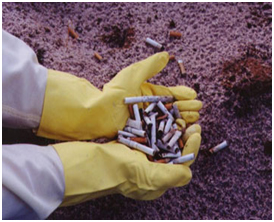Environmental Exposure
 Research that will advance policies to reduce environmental exposure to the toxic effects of tobacco smoke, tobacco smoke residue, cigarette butts, and other tobacco products.
Research that will advance policies to reduce environmental exposure to the toxic effects of tobacco smoke, tobacco smoke residue, cigarette butts, and other tobacco products.
Environmental contamination by cigarette waste and exposure to smoke and smoke residue warrants intensified research attention for the potential to inform a new generation of tobacco control efforts.
Once the nation’s leader in protecting workers from the toxic effects of secondhand smoke, California has fallen behind. Twenty-four other states and the District of Columbia provide greater secondhand smoke protection in the workplace than California1. The status of tobacco control within the State challenges TRDRP to focus its limited resources in areas with the potential to result in the evidence to develop, implement, and enforce the public policies and programs necessary to halt and reverse such trends.
1Centers for Disease Control and Prevention. Press Release, New CDC Report Says Increased Efforts, High-Impact Strategies Needed to Reduce Smoking and Save Lives. April 23, 2010. Available at the CDC Online Newsroom here
Cigarette Butt Pollution
Cigarette butts are the most common form of plastic litter on the beaches of the U.S. and worldwide. 141 million pounds of filters were dumped into the US environment in 2005.
Learn more in an article by Dr. Tom Novotny, a TRDRP-funded investigator.
 Thirdhand Smoke (THS)
Thirdhand Smoke (THS)
Thirdhand smoke is the residue left from smoking on clothes, walls, furniture, pets, rugs and people. In a groundbreaking TRDRP-funded study, researchers at the Lawrence Berkeley National Laboratory recently discovered that residual nicotine from tobacco smoke sorbed to indoor surfaces reacts with the common indoor air pollutant, nitrous acid, to form carcinogenic tobacco-specific nitrosamines (TSNAs), an unappreciated health hazard through skin exposure, dust inhalation, and ingestion.
TRDRP recently funded a Thirdhand Smoke Research Consortium comprised of researchers from UC San Francisco, Lawrence Berkeley National Laboratory, UC Riverside, University of Southern California, and San Diego State University to study the chemistry, exposure, toxicology, risk assessment and policy implications of THS. >Read more
Learn more in an article by Dr. Georg Matt and others on this subject.
 Secondhand Smoke and Multiunit Housing
Secondhand Smoke and Multiunit Housing
Policies to address secondhand smoke in multiunit housing are a new frontier in California’s tobacco control efforts. As laws and policies are enacted throughout the state, more research is needed to evaluate their effectiveness and to inform community-wide implementation, particularly in poor and minority communities.
Go to the Tobacco Control Legal consortium website to read more about regulating smoking in multiunit housing.
Go to the website of the Center for Tobacco Policy & Organizing to see comparisons of nonsmoking ordinances across California.

 Research Highlights: Richmond’s Smoking Ban: Ensuring Impact >
Research Highlights: Richmond’s Smoking Ban: Ensuring Impact > Current funding opportunities for research related to this TRDRP priority.
Current funding opportunities for research related to this TRDRP priority.